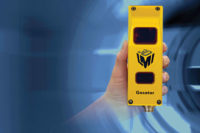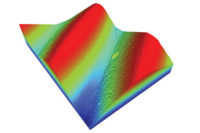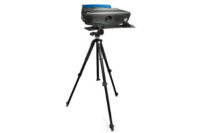A major manufacturer of building materials wanted to add 100% inline dimensional inspection to its manufacturing line. Any visible waviness in the product material surface would be unacceptable aesthetically. LMI offered a solution based on its Gocator all-in-one 3-D smart laser line sensors. Agreeably, LMI sensors would achieve the desired inspection capability. However, the manufacturer needed a complete turnkey system of six sensors with mechanical mounting, environmental protection, data analysis, custom displays and data communication. LMI introduced the manufacturer to Cyth Systems, a leading integration and engineering firm headquartered in Southern California with pioneering success in designing and building automated test systems, machine vision systems, and embedded control systems.
The manufacturer hired Cyth Systems to be the system integrator for the Gocator sensors. According to Kevin Ruckley, Engineering Manager at Cyth, “This was an application where the technology was a perfect fit.”
The first step in the project, following a procedure that Cyth uses in all such applications, was to provide a demonstration for the manufacturer on one of its production lines. Two Gocator sensors were mounted over the production conveyor to show measurement capability and assist in completing the list of requirements for the full installation.
The sensors chosen for the project were Gocator 2300 series. These sensors feature megapixel imagers to provide high measurement resolution over a large field of view at scan rates up to 5 kHz. Building materials can travel at about 90m per minute, requiring high scan rates for full surface coverage. Since building materials can be up to 1.5m wide, multiple sensors were mounted in a side-by-side configuration (Figure 1). Cyth used an LMI Master 800 as an easy way to provide power distribution and synchronization to the sensors.
The Gocator sensors are sealed, but their optical windows need to be kept reasonably clean for proper operation despite a manufacturing environment that is very harsh. To protect the sensors from the plant environment, Cyth manufactured a sensor enclosure with cutouts for the sensors. The enclosure is connected to a clean compressed air source to maintain a positive pressure inside to keep dirt away from the sensors.
One “red flag” found during the test phase was that building materials could show some vibration or bouncing on the conveyor. To eliminate this potential source of error, Cyth installed a plastic plate at the inspection station to provide a stable reference surface.
The six sensors generate masses of data, which need to be reduced to simple, easy-to-understand data displays for the user. Cyth’s extensive expertise in NI LabVIEW provided a good platform for sensor control and data analysis. To import raw sensor data into their analysis system, Cyth used the Gocator SDK to create a LabVIEW driver. According to Kevin Ruckley, “during the integration phase, the LMI Technical Support team answered all questions allowing us to develop a complete drive.”
The manufacturer requested the implementation of Wonderware for its operator interface and data display using large screens for easy viewing. To meet this request, Cyth created a driver to output LabVIEW data to Wonderware (Figure 2). Data displays are available on the manufacturer’s plant network, providing remote viewing throughout the facility.
The integrated system was installed in late 2012 at one of the manufacturer’s production facilities, delivering 100% in-process monitoring to ensure production of the highest quality building materials.
Gocator sensors provided the measurement capability required for this inline dimensional measurement application. Cyth Systems provided turnkey system integration services to meet the full needs of the manufacturer and found that the Gocator sensors were the easiest 3-D sensor to integrate with excellent support by the LMI technical team.
LMI Technologies





